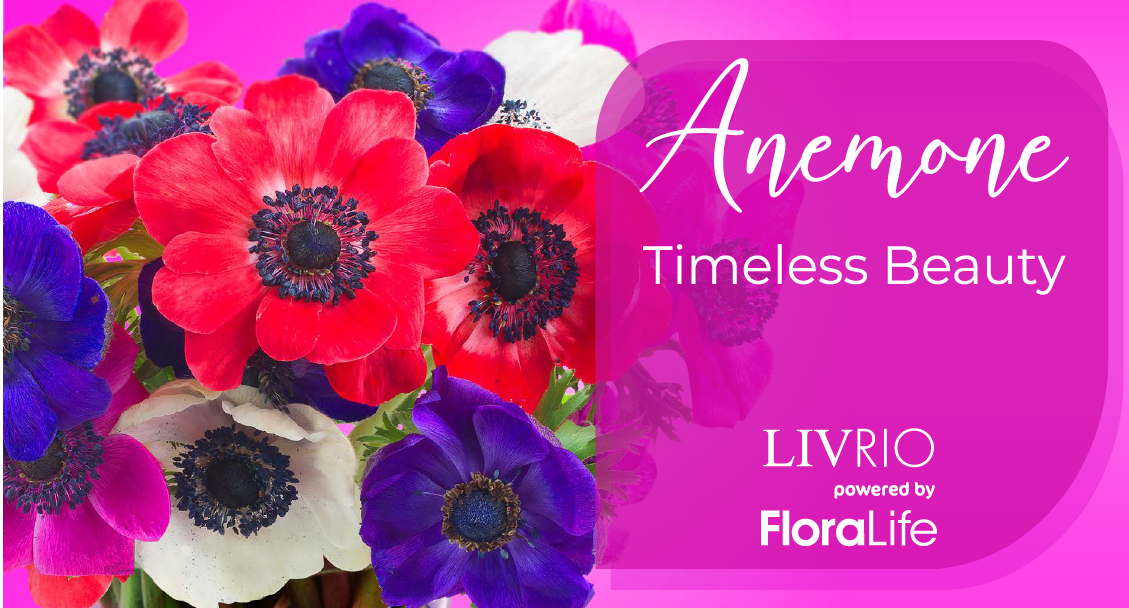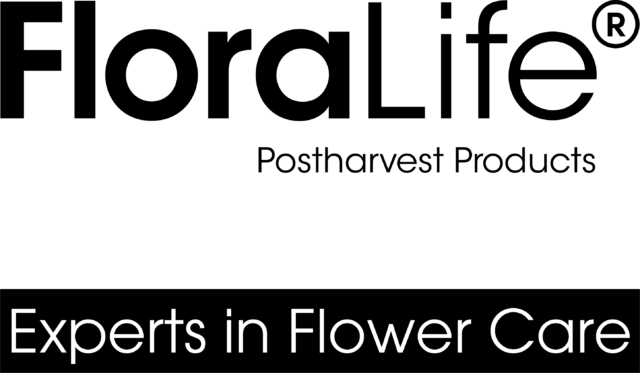Anemone: Timeless Beauty
LivRio Magazine August 2023, powered by FloraLife

Anemones belong to one of the most horticulturally popular plant families, Ranunculaceae, and are cousins to other cut-flower beauties such as Delphinium, Clematis, and Ranunculus. Species of Anemones can be found growing wild globally except for in Australia, New Zealand, and Antarctica.
The Anemone variety that is used in cut-flower productions is Anemone Coronaria, which is so named due to its striking ring of black anthers in the center of each flower which resemble a crown.
Native to the Mediterranean regions, Anemone Coronaria was first introduced to Great Britain sometime prior to 1596 and was quite popular during the reign of Queen Elizabeth I (1558-1603). Their enduring popularity stands as a testament to their outstanding beauty and versatility.
Whether your vibe is classic white, coastal grandmother, hot pink like Barbie, or dark and moody purple à la Wednesday Addams, Anemones are guaranteed to deliver with a serving of added drama.
Care and Handling Information
Purchasing
- Anemones can be ethylene sensitive, leading to petal shatter and a shortened vase life if left untreated. Insist that your supplier treats with an ethylene action inhibitor such as EthylBloc™ or FloraLife® EthylGuard at farm level to protect against exposure. Do not store or display near ripening produce or products that produce ethylene.
- Choose strong stems with flowers closed or just beginning to open, although be aware that flowers will close naturally when in cold and dark conditions.
- Inspect for bruising and botrytis.
Shipping and Storage
- Shipping and storage temperatures should be 34 – 38° F (1-3C).
- Stems should be shipped and packaged to minimize damage in transit.
- Anemones are susceptible to stem bending and may benefit from upright shipment.
Re-hydration At Store Level and Storage
- Start processing with a clean bucket, sanitized with FloraLife® D.C.D.® Cleaner.
- If received dry packed, conditioning of stem ends is recommended to prevent blockage and promote uptake. Cut approximately 1” or more off stems. Use clean, sanitized clippers or knife, and treat with FloraLife® Quick Dip.
- Place flowers in a flower food holding solution such as FloraLife® Express 200. Do not put flowers directly in metal/galvanized buckets. Use clean, high-quality water that has not been treated with a water softener as the salt levels can be damaging to flowers.
- Store in a cooler at 34 – 38° F (1-3C).
- Allow minimum 2 hours to hydrate placing buckets in an area with good airflow.
- Always remember FIFO (first in/first out) when rotating Anemones or any other flowers.
Vase Care
- Start processing with a clean bucket, sanitized with FloraLife® D.C.D.® Cleaner.
- If received dry packed, conditioning of stem ends is recommended to prevent blockage and promote uptake. Cut approximately 1” or more off stems. Use clean, sanitized clippers or knife, and treat with FloraLife® Quick Dip.
- Place flowers in a flower food holding solution such as FloraLife® Express 200. Do not put flowers directly in metal/galvanized buckets. Use clean, high-quality water that has not been treated with a water softener as the salt levels can be damaging to flowers.
- Store in a cooler at 34 – 38° F (1-3C).
- Allow minimum 2 hours to hydrate placing buckets in an area with good airflow.
- Always remember FIFO (first in/first out) when rotating Anemones or any other flowers.
Common Defects
- Petal shatter – associated with ethylene sensitivity.
- Relatively short vase life (3-8 days).
- Leaf yellowing – may benefit from bulb specific flower foods.
- Stem bending – may benefit from upright shipping.
- Prone to water stress – dry shipped flowers should be processed immediately into holding solution.
- Prone to mechanical damage – Stems and blooms are very delicate. Bunches should be secure but not strapped too tightly or stems will bruise or break. Do not over pack boxes to allow good airflow.
Special Considerations
- Other causes for poor vase life can be cut stage, product age (stored too long) or storing dry for long periods.
- Opening speed is fast.
- Anemones can be mixed with most other flowers without any negative or harmful effects. However, do not mix daffodils in the same vase.
- Due to their shorter vase life, pair with flowers that have similar characteristics. If designing in foam use Oasis® Maxlife foam to reduce potential burn. Always cut at a sharp angle before inserting into foam. Create designs as close to event as possible. Check water levels or foam periodically to be sure flowers stay hydrated.
- Sap may irritate skin, be conscientious when designing with Anemones and treat any irritation immediately.
For more information, click here:
- https://floralife.com/article/anemone-troubleshooting/
- https://floralife.com/flowers/anemone/
- https://floralife.com/flower-library-for-retailers/
*Product availability depends upon geographical region.
Check https://floralife.com/products/#product_grid for more information.
